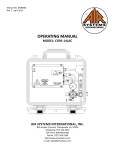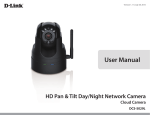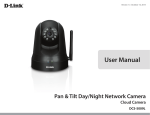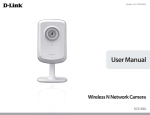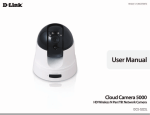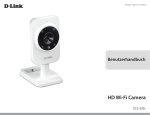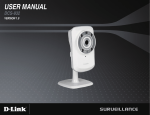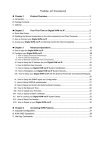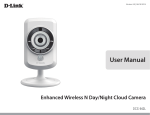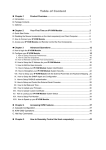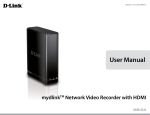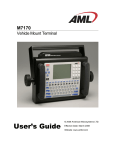Download User Manual
Transcript
Version 1.01 | 09/12/2014 User Manual HD Wi-Fi Camera DCS-935L Manual Overview D-Link reserves the right to revise this publication and to make changes in the content hereof without obligation to notify any person or organization of such revisions or changes. Information in this document may become obsolete as our services and websites develop and change. Please refer to the www.mydlink.com website for the most current information. Manual Revision Revision Date Description 1.00 Sept. 11, 2014 DCS-935L Revision A1 with firmware version 1.00 1.01 Sept. 12, 2014 Add mydlink Home app Trademarks D-Link and the D-Link logo are trademarks or registered trademarks of D-Link Corporation or its subsidiaries in the United States or other countries. All other company or product names mentioned herein are trademarks or registered trademarks of their respective companies. Copyright © 2014 by D-Link Corporation. All rights reserved. This publication may not be reproduced, in whole or in part, without prior expressed written permission from D-Link Corporation. Table of Contents Table of Contents Product Overview............................................................... 5 Package Contents.......................................................................... 5 System Requirements.................................................................. 5 Introduction.................................................................................... 6 Features............................................................................................. 7 Hardware Overview...................................................................... 8 Front View................................................................................. 8 Rear View.................................................................................. 9 Installation........................................................................10 Wireless Installation Considerations.....................................11 Zero Configuration Setup.........................................................12 Mobile App Setup.......................................................................15 Mounting the Camera...............................................................16 mydlink............................................................................................17 Configuration....................................................................18 Accessing the Web Configuration Utility............................18 Live Video.......................................................................................19 Setup................................................................................................21 Wizard......................................................................................21 Internet Connection Setup Wizard.........................22 Network...................................................................................25 Wireless Setup.......................................................................27 Dynamic DNS .......................................................................28 Image Setup..........................................................................29 D-Link DCS-935L User Manual Audio and Video...................................................................30 Motion Detection................................................................31 Sound Detection..................................................................32 Mail...........................................................................................33 FTP.............................................................................................34 Snapshot.................................................................................35 Video Clip...............................................................................36 Time and Date.......................................................................37 Day/Night Mode..................................................................38 Maintenance.................................................................................39 Admin......................................................................................39 System.....................................................................................40 Firmware Upgrade...............................................................41 Status...............................................................................................42 Device Info.............................................................................42 System Log.............................................................................43 Event Log................................................................................44 Wireless Security..............................................................45 What is WEP?.................................................................................45 What is WPA?.................................................................................46 Configuring the DCS-935L with a Router...........................47 Troubleshooting...............................................................53 Wireless Basics..................................................................55 3 Table of Contents Wireless Modes.............................................................................59 Networking Basics............................................................60 Check your IP address................................................................60 Statically Assign an IP Address...............................................61 Technical Specifications...................................................62 D-Link DCS-935L User Manual 4 Section 1 - Product Overview Product Overview Package Contents • DCS-935L HD Wi-Fi Camera • Power Adapter • Quick Install Guide • Mounting Kit If any of the above items are missing, please contact your reseller. Note: Using a power supply with a different voltage than the one included with your product will cause damage and void the warranty for this product. Note: You can power this camera with a USB battery that supplies 5 V and at least 1.5 A of power. System Requirements • Computer with Microsoft Windows® 8/7/Vista, or Mac with OS X 10.6 or higher • PC with 1.3GHz or above and at least 128MB RAM • Internet Explorer 7, Firefox 12, Safari 6, or Chrome 20 or higher version with Java installed and enabled • Existing 802.11b/g/n/ac wireless network • iPhone, iPad, or Android smartphone or tablet* * Please refer to the mobile app’s store page to check whether your device is compatible. D-Link DCS-935L User Manual 5 Section 1 - Product Overview Introduction Congratulations on your purchase of the DCS-935L HD Wi-Fi Camera. The DCS-935L is a versatile and unique solution for your small office or home. Unlike a standard webcam, the DCS-935L is a complete system with a built-in CPU and web server that transmits high quality video images for security and surveillance. The IR LED provides around the clock surveillance regardless of the lighting conditions. The DCS-935L can be accessed remotely, and controlled from any PC/Notebook over your local network or through the Internet via a web browser. The simple installation and intuitive web-based interface offer easy integration with your Ethernet/Fast Ethernet or 802.11b/g/n/ac wireless network. The DCS-935L also comes with remote monitoring and motion/sound detection features for a complete and cost-effective home security solution. D-Link DCS-935L User Manual 6 Section 1 - Product Overview Features Simple to Use The DCS-935L is a stand-alone system with a built-in CPU, requiring no special hardware or software such as PC frame grabber cards. The DCS-935L supports both ActiveX mode for Internet Explorer and Java mode for other browsers such as Firefox® and Safari®. Supports a Variety of Platforms Supporting TCP/IP networking, HTTP, and other Internet related protocols. The DCS-935L can also be integrated easily into other Internet/Intranet applications because of its standards-based features. Wireless AC Support The DCS-935L offers 802.11ac wireless, making the DCS-935L easy to integrate into your existing network environment. The DCS-935L also works 802.11n/g/b routers or access points for added flexibility. The Site Survey feature also allows you to view and connect to any available wireless networks. Web Configuration Using a standard Web browser, administrators can configure and manage the Network Camera directly from its own Web page via Intranet or Internet. This means you can access your DCS-935L anytime, anywhere in the world. Broad Range of Applications With today’s high-speed Internet services, the Network Camera can provide the ideal solution for delivering live video images over the Intranet and Internet for remote monitoring. The Network Camera allows remote access using a Web browser for live image viewing, and allows the administrator to manage and control the Network Camera anytime, anywhere in the world. Many applications exist, including industrial and public monitoring of homes, offices, banks, hospitals, child-care centers, and amusement parks. Comprehensive Day/Night Surveillance The built-in infrared LEDs enable night time viewing of up to 16 feet (5 meters), allowing you to keep watch over an area, even in complete darkness. D-Link DCS-935L User Manual 7 Section 1 - Product Overview Hardware Overview Front View Microphone IR LEDs Camera Lens Light Sensor D-Link DCS-935L User Manual 8 Section 1 - Product Overview Rear View Direct Button microUSB Port (for power) Power and Link LED Reset Button WPS Button Camera Stand D-Link DCS-935L User Manual 9 Section 2 - Installation Installation There are two ways to set up your camera: Zero Configuration Setup: If you have a mydlink-enabled router (D-Link cloud router), this is the easiest way to set up your camera. Refer to Zero Configuration Setup on page 12. mydlink Home Mobile App: If you do not have a mydlink-enabled router, you can use the mydlink Home mobile app to guide you through setup and initial configuration of your camera. Refer to Mobile App Setup on page 15. D-Link DCS-935L User Manual 10 Section 2 - Installation Wireless Installation Considerations The D-Link Wireless Network Camera lets you access your network using a wireless connection from anywhere within the operating range of your wireless network. However, the number, thickness and location of walls, ceilings, or other objects that the wireless signals must pass through, may limit the range. Typical ranges vary depending on the types of materials and background RF (radio frequency) noise in your home or business. The key to maximizing wireless range is to follow these basic guidelines: 1. Minimize the number of walls and ceilings between your adapter and other network devices (such as your Network Camera) - each wall or ceiling can reduce your adapter’s range from 3-90 feet (1-30 meters). 2. Be aware of the direct line between network devices. A wall that is 1.5 feet thick (.5 meters), at a 45-degree angle appears to be almost 3 feet (1 meter) thick. At a 2-degree angle, it looks over 42 feet (14 meters) thick. Position your devices so that the signal will travel straight through a wall or ceiling (instead of at an angle) for better reception. 3. Building Materials make a difference. A solid metal door or aluminum studs may weaken the wireless signal. Try to position your access points, wireless routers, and other networking devices where the signal passes through drywall or open doorways. Materials and objects such as glass, steel, metal, walls with insulation, water (fish tanks), mirrors, file cabinets, brick, and concrete will degrade your wireless signal. 4. Keep your product at least 3-6 feet or 1-2 meters away from electrical devices or appliances that generate RF noise. 5. If you are using 2.4GHz cordless phones or other radio frequency sources (such as microwave ovens), your wireless connection may degrade dramatically or drop completely. Make sure your 2.4GHz phone base is as far away from your wireless devices as possible. The base transmits a signal even if the phone in not in use. D-Link DCS-935L User Manual 11 Section 2 - Installation Zero Configuration Setup If you have a mydlink-enabled Cloud Router, you can take advantage of Zero Configuration Setup. Zero Configuration automatically configures your camera’s settings for you, and adds the camera to your mydlink account automatically. This type of setup allows you to set up your camera by simply plugging it in and connecting it to your router. Connect your camera to your mydlink-enabled Cloud Router and Zero Configuration will automatically configure your DCS-935L and add the camera to your mydlink account. After the short time it takes to do this you can remotely access your camera from the website (http://www.mydlink.com) to manage and monitor your DCS-935L. Plug in the External Power Adapter Connect the power adapter to the microUSB port on the back of the camera. Plug the power adapter in to a wall outlet. Press the WPS button on your camera Press and hold the WPS button for three seconds. The blue WPS status LED will start blinking. Press the WPS button on your Cloud Router Press the WPS button on your router within 60 seconds. The WPS button is usually on the side or back of your Cloud Router. The DCS-935L will automatically create a secure wireless connection to your router and reboot. When it has successfully connected, the Power LED will be lit green and the Direct LED will be turned off. D-Link DCS-935L User Manual 12 Section 2 - Installation Check Your mydlink Account From any computer with an Internet connection, open a web browser and login to your mydlink account. The mydlink page will check for new devices and display a New device Found! pop-up notification in the bottom-left corner. Click the notification to continue. DCS-935L A summary and confirmation notification will appear with the automatically configured details. Make a note of the details and click Yes to add the camera to your account. DCS-935L D-Link DCS-935L User Manual 13 Section 2 - Installation Zero Configuration will navigate to the mydlink Live View tab for your camera where you will see a screen similar to the following. Your camera is now set up, and you can skip to mydlink on page 17 to learn more about the mydlink features of this camera, or to Configuration on page 18 for advanced configuration of your camera. Note: If you see a white haze when viewing in night vision mode, the night vision light on the camera may be reflecting off a nearby surface. Try repositioning and aiming the camera. D-Link DCS-935L User Manual 14 Section 2 - Installation Mobile App Setup If you do not have a mydlink-enabled Cloud Router, you can configure your camera through the mydlink Home mobile app. Search for the free mydlink Home app on the App Store or Google Play and download it to your smartphone or tablet. You can also use a QR code reading app to scan the corresponding code for your device below. Launch the mydlink Home app and tap on the gear icon at the top left, then tap the Add new device button. Follow the onscreen prompts to set up and install your camera. D-Link DCS-935L User Manual 15 Section 2 - Installation Mounting the Camera To mount your camera on a wall or ceiling, please follow the steps below. It is recommended that you configure the camera before mounting. Depending on the material of the wall or ceiling, use proper tools to drill two holes 25mm deep, 40mm apart with a 6mm drill bit where you marked. Insert the screws into the holes. If the wall is made out of concrete, drill the holes first, then insert the plastic anchors to support the screws. Place the mounting base over the screws that are mounted on the wall. Make sure to fit the screw-heads over the big holes and slide it downward to lock firmly. Lightly pull the base forward to make sure that it is locked. Adjust the angle of the camera as desired. D-Link DCS-935L User Manual 16 Section 2 - Installation mydlink After registering your camera with a mydlink account in the Camera Installation Wizard, you will be able to remotely access your camera from the www.mydlink.com website. After signing in to your mydlink account, you will see a screen similar to the following: For more details on using your camera with mydlink, go to the Support section of the mydlink website and check the User Manual section for your product to find the latest instruction guide for your camera’s mydlink features. D-Link DCS-935L User Manual 17 Section 3 - Configuration Configuration Accessing the Web Configuration Utility After installing and setting up your camera with the mydlink Home app, you are ready to use your camera. The camera’s built-in Web configuration utility is designed to allow you to easily access and configure your DCS-935L. To log in, use a web browser on your PC to go to the www.mydlink.com website and log in to your account. Select your camera, click on the Settings tab, then click on the Advanced Settings button. Use the User name admin and the password you created while setting up the camera. If you did not create a password, the default password is blank. After entering your password, click OK. Note: If you are directly connecting your PC to the camera, the default IP is 10.255.255.1 Please make sure that you have the latest version of Java application installed on your computer to ensure proper operation when viewing the video in Java mode. The Java application can be downloaded at no cost from Sun’s web site (http://www.java.com). When you connect to the home page of your camera, you may be prompted to download ActiveX. If you want to use ActiveX to view your video images instead of Java, then you must download ActiveX. D-Link DCS-935L User Manual 18 Section 3 - Configuration Live Video The Live Video page lets you view the live video stream from your camera. You can choose which video profile to view by selecting H.264 or MJPEG. For information on adjusting the video profiles, refer to Audio and Video on page 30. Please make sure that you have the latest version of Java installed on your computer to ensure proper operation when viewing the video in Java mode. The Java application can be downloaded free from Sun’s web site (http://www.java.com). D-Link DCS-935L User Manual 19 Section 3 - Configuration Icon Button Name Full Screen button Function Switches to a full screen view of the camera video. Snapshot button Takes a snapshot of the image currently displayed on the screen and saves it to the hard drive in the folder specified using the Storage folder button. Triggers the camera’s recording function. This will record the video displayed on the screen and saves it to the hard drive in the folder specified using the Storage folder button. Sets the storage folder for snapshots and video recordings. Video recording button Storage folder button Listen button Sends the audio received from the camera’s microphone through to the PC’s speakers. IR LED On/Off button Turns the Infrared lights on or off. (The icon only appears when you activate the manual IR option which can be found under the Day/Night Mode section of the Audio and Video Setup tab.) Zoom buttons D-Link DCS-935L User Manual Zooms in or out of the picture. 20 Section 3 - Configuration Setup Wizard This section allows you to begin setup wizards which will guide you through the process of getting your camera’s various functions configured. If you comfortable with adjusting the settings manually, you may skip the wizards and adjust settings manually as needed. Internet You may choose to configure your network by Connection using the Internet Connection Setup Wizard that Setup Wizard: includes step-by-step instructions. Please refer to Internet Connection Setup Wizard on page 22 for more details. Manual Internet If you would rather manually set up the camera Connection internet connection, you can refer to Network Setup: on page 25 which provides more details on the information required. D-Link DCS-935L User Manual 21 Section 3 - Configuration Internet Connection Setup Wizard This wizard will guide you through a step-by-step process to configure your new D-Link Camera and connect the camera to the Internet. Click Next to continue. Select how the camera will connect to the Internet. If your router is connected to a router, or you are unsure how your camera will connect to the Internet, select DHCP Connection. If your ISP has assigned you a static IP, select Static IP Address and enter the following details: IP Address: Enter the IP address that the camera will use on your network. You may need to get this information from your ISP or network administrator. Subnet Mask: The default value is “255.255.255.0.” Used to determine if the destination is part of the same network segment. Default Gateway: The gateway used to forward data to destinations in a different subnet. Invalid gateway settings may cause the failure of transmissions to a different subnet. Primary DNS: Primary domain name server that translates names to IP addresses. Secondary DNS: Secondary domain name server to backup the Primary DNS. If you are required to connect using PPPoE, select PPPoE and enter the User ID and Password for your PPPoE connection. Click Next to continue. D-Link DCS-935L User Manual 22 Section 3 - Configuration A Dynamic DNS account allows you to access your camera over the Internet when you have an IP address that changes each time you connect to the Internet. If you have a Dynamic DNS account, click DDNS Enable and enter the following details: Server Address: Select your Dynamic DNS Server from the pull down menu. Host Name: Enter the host name of the DDNS server. User Name: Enter your username or e-mail address used to connect to the DDNS. Password: Enter your password used to connect to the DDNS server. Timeout: You can setup how often the camera notifies the DDNS server of its current global IP address by entering a whole number in hours. Click Next to continue. Enter a name for your camera. Click Next to continue. Select the time zone that the camera is in so that scheduled events occur at the correct time. Click Next to continue. D-Link DCS-935L User Manual 23 Section 3 - Configuration A summary of the options you selected is displayed for confirmation. If you are happy with the selected configuration, click Next. Otherwise, click Back to make the required changes. D-Link DCS-935L User Manual 24 Section 3 - Configuration Network This section allows you to configure your network settings. DHCP Select this connection if you have a DHCP server running on your network and Connection: would like a dynamic IP address to be updated to your camera automatically. Static IP Address: You may obtain a static or fixed IP address and other network information from your network administrator for your camera. IP Address: Enter the IP address that the camera will use on your network. You may need to get this information from your ISP or network administrator. Subnet Mask: The default value is “255.255.255.0.” Used to determine if the destination is part of the same subnet. Default Gateway: The gateway used to forward frames to destinations in a different subnet. Invalid gateway settings may cause the failure of transmissions to a different subnet. Primary DNS: Primary domain name server that translates names to IP addresses. Secondary DNS: Secondary domain name server to backup the Primary DNS. PPPoE Settings: If you are using a PPPoE connection, enable it and enter the User ID(username) and Password for your PPPoE account. You can get this information from your Internet service provider (ISP). D-Link DCS-935L User Manual 25 Section 3 - Configuration Port Settings: You may configure which ports to use for HTTP and RTSP access to the camera. HTTPS Settings: You may enable and configure which ports to use for HTTPS access to the camera. UPnP Enable: Enable this setting to configure your camera as an UPnP device in the network. UPnP Port Enable this to allow your camera to use UPnP to configure port forwarding on Forward: your router. Set the HTTP, HTTPS, and RTSP ports you wish to use for UPnP port forwarding. Bonjour: Checking the Bonjour box will allow the camera to be discoverable on the network and visible to Apple devices. Click Save Settings to save your changes. D-Link DCS-935L User Manual 26 Section 3 - Configuration Wireless Setup This section allows you to set up and configure the wireless settings on your camera. SSID: Enter the network name(SSID) of the wireless network you want to connect to. You can also click the Site Survey button below to choose an available network and fill in settings automatically. Connection Use Infrastructure if you are connecting your camera to a wireless router or Mode: access point. Use Ad-Hoc if you are wirelessly connecting to your PC without a wireless router or access point. Security Mode: For security, you can choose None, WEP, WPA-PSK, or WPA2-PSK. Select the same encryption method that is being used by your wireless device/ router. Cipher Type: If you chose WPA-PSK or WPA2-PSK, choose whether to use TKIP or AES. Pre-Shared Key: Enter the key(password) for your wireless network. Check the Show Hidden Key box to reveal the password you have entered. Click the Save Settings button to save your changes. D-Link DCS-935L User Manual 27 Section 3 - Configuration Dynamic DNS DDNS allows you to access your camera using a domain name instead of an IP address. To do this, you will need to have an account with one of the DDNS services listed in the drop-down box on this page. DDNS: Check this box to enable the DDNS function. Server Address: Select your Dynamic DNS Server from the pull down menu. Host Name: Enter the host name of the DDNS server. User Name: Enter your username or e-mail address used to connect to the DDNS server. Password: Enter your password used to connect to the DDNS server. Timeout: You can set up how often the camera notifies the DDNS server of its current global IP address by entering a whole number in hours. Click the Save Settings button to save your changes. D-Link DCS-935L User Manual 28 Section 3 - Configuration Image Setup This section allows you to configure the image settings for your camera. Brightness: Allows you to adjust the brightness level. Contrast: Allows you to adjust the contrast level. Sharpness: Allows you to adjust image sharpness. Mirror: Horizontally flip the video. Frequency: Adjusts the video output. By default this is set to Off, but you may override the setting by manually selecting either 50Hz or 60Hz Saturation: Allows you to adjust the saturation level. Hue: Allows you to adjust the hue of the video. B/W: Changes the images recorded on the camera to be in black and white. Flip: Check this box to vertically flip the video. If the camera is installed upside down, Flip Image and Mirror should both be checked. Click the Save Settings button to save your changes. D-Link DCS-935L User Manual 29 Section 3 - Configuration Audio and Video This section allows you to configure the audio and video settings for your camera. Encode Type: Your camera has separate settings for the H.264 and MJPEG video streams. Resolution: Select the desired video resolution from 1280x720, 800x600, 720x480, 640x480, and 320x240. Higher settings offer better quality, but will require more bandwidth to stream. Bit Rate/JPEG Select the bitrate(H.264) or quality(MJPEG) for the video stream. Higher bitrates Quality: and quality will require more bandwidth. Frame Rate: Select the frame rate(FPS) to use for the video stream. Higher settings offer better quality, but will require more bandwidth to stream. RTSP URL: The URL used to connect to the camera when viewing from QuickTime or a mobile device. Microphone Check this box to enable the camera’s microphone. Enable: Volume: Use this dropdown box to adjust the volume of the camera’s audio. Click Save Settings to save your changes. D-Link DCS-935L User Manual 30 Section 3 - Configuration Motion Detection Motion detection enables the camera to monitor the video feed for movement. Here, you can adjust the sensitivity and percentage settings, which work together to determine whether motion is detected by the camera or not. Enable Video Select this box to enable the motion detection feature of your camera. Motion: Sensitivity: Specifies how sensitive motion detection will be from 0% to 100%. A low sensitivity setting means that there must be large changes between two images in order to detect motion, and a high sensitivity setting means that even small changes will cause motion to be detected. Low sensitivities may be useful when monitoring an area that has flickering lights or a window to the outside in view. High sensitivities may be useful when monitoring an area that rarely changes, such as a storeroom or warehouse. Percentage: Specifies how much of the area being monitored for motion must change for motion to be detected. A low percentage means that only part of the area being monitored needs to change to detect motion, and a high percentage means that most of the area needs to change to detect motion. Low percentages can be useful when monitoring a large area such as an entire room, and high percentages can be useful when you are only monitoring a specific part of the camera’s view, such as a doorway. Drawing Mode: Select Draw Motion Area to select the area of the picture to monitor for movement to trigger recording or a snapshot. Use your mouse to click and drag on the area that you would like to monitor for motion. Select Erase Motion Area to clear a selected region and stop the camera from monitoring that area of the picture. Clear: Clears all motion detection areas from the picture. Click Save Settings to save your changes. D-Link DCS-935L User Manual 31 Section 3 - Configuration Sound Detection Motion detection enables the camera to monitor the environment for loud sounds. You may set the volume threshold used to determine whether sound was detected or not. If this option is selected, the trigger by option under Video Clip, or Snapshot should also be selected. Enable Sound Select this box to enable the sound detection feature of your camera. Detection: Detection Level: Specify the volume level that a sound must exceed in order to trigger the sound detection feature. Click Save Settings to save your changes. D-Link DCS-935L User Manual 32 Section 3 - Configuration Mail This section allows you to configure your camera to send snapshots and video clips to an e-mail address. If you are not sure what settings to use, check with your e-mail service provider. SMTP Server This is the domain name or IP address of your external e-mail server. Address: SMTP Server This is the port used by your external e-mail server. Port: Sender e-mail This is the e-mail address listed as the sender for your notification e-mails. Address: Receiver e-mail This is the e-mail address that your notification e-mails will be sent to. Address: User Name: If the SMTP server uses authentication, enter your user name. Password: If the SMTP server uses authentication, enter your password. Use SSL-TLS/ If your SMTP server requires SSL-TLS or STARTTLS, select it here. STARTTLS For example, if you want to use Gmail with SSL-TLS for e-mail notifications, you can follow the setup procedure as below: Step 1 - Enter “smtp.gmail.com” in SMTP Server Address. Step 2 - Change the SMTP server port number from 25 to 465. Step 3 - Enter your gmail e-mail address in Sender E-mail Address. Step 4 - Enter the destination e-mail address in Receiver E-mail Address. Step 5 - Enter the user name required to access the SMTP server. Step 6 - Enter the password required to access the SMTP server. Step 7 - Select SSL-TLS and then click Save Settings. Step 8 - Click the Test button to send a test e-mail will be sent. Note: You can also use STARTTLS, which will use SMTP server port number 587. If you want to use a Yahoo SMTP server, the SMTP server address will be different between each registered region, and only SMTP port 465 is supported for SSLTLS. D-Link DCS-935L User Manual 33 Section 3 - Configuration FTP This section allows you to configure your camera to send snapshots and video clips to an FTP server. Host Name: Enter the IP address of the FTP server that you will be connecting to. Port: Enter the port of the FTP server that you will be connecting to. User Name: Enter the user name of your FTP server account. Password: Enter the password of your FTP server account. Path: Enter the destination path/folder to save files to on the FTP server. Passive Mode: Enabling passive mode may help you reach your FTP server if your camera is behind a router protected by a firewall. Test FTP Server: Clicking on the Test button will send a test JPEG snapshot to the FTP server specified above to make sure that your settings are correct. D-Link DCS-935L User Manual 34 Section 3 - Configuration Snapshot The snapshot feature lets you send image snapshots via FTP or e-mail when a trigger is activated. Snapshot: Check this box to enable the Snapshot function. Trigger By: Select whether to record when triggered by Motion or Sound, according to a Schedule or Always record. Snapshot Type: Select whether to take a single snapshot or to take 6 snapshots with a selectable interval between them. Target: Select where you want the snapshot to be sent. It may be uploaded to an FTP or sent to an e-mail address. Click Save Settings to save your changes. D-Link DCS-935L User Manual 35 Section 3 - Configuration Video Clip Video Clip allows you to send video clips via FTP or e-mail when a trigger is activated. Video Clip: Check this box to enable the Video Clip function. Trigger By: Select whether to record when triggered by Motion or Sound, according to a Schedule or Always record. Video Clip: Here you can specify how much video to record before and after the event. Target: Select where you want the video clip to be sent. It may be uploaded to an FTP or sent to an e-mail address. Click Save Settings to save your changes. D-Link DCS-935L User Manual 36 Section 3 - Configuration Time and Date This section allows you to configure the settings of the internal system clock for your camera. Time Zone: Select the time zone for your region from the drop down menu. Daylight Saving: If your region uses Daylight Saving time, you can enable it here. Select Set DST Manually if you want to manually set the offset and the period of time that the Daylight Saving correction should be used. Synchronize NTP Network Time Protocol will synchronize your camera with an Internet time Server: server. Choose the one that is closest to your camera. Set the Date and If Synchronize NTP Server is disabled, you can set the date and time manually. Time Manually: You can also click the Copy Your Computer’s Time Settings button to automatically copy the date and time of the PC you are using. Click Save Settings to save your changes. D-Link DCS-935L User Manual 37 Section 3 - Configuration Day/Night Mode This section allows you to configure when Day and Night modes are used. Day mode uses the infrared cut filter to provide a corrected color image for times where there is available lighting. Night mode moves the filter out of the way to use all available light, and turns on the IR LED illuminators to allow for clear black and white video in dark areas with little to no light. Auto: This mode will automatically switch between Day and Night mode based on the amount of available lighting. Manual: This mode allows you to manually switch between modes through the Live Video page. Always Day This sets the camera to always use Day mode. Mode: Always Night This sets the camera to always use Night mode. Mode: Day Mode This sets the camera to use Day mode during the times you specify, and will Schedule: switch to Night mode outside the times you specify. D-Link DCS-935L User Manual 38 Section 3 - Configuration Maintenance Admin This section allows you to change the administrator’s password and configure the server settings for your camera. You can also manage the user account(s) that are allowed to access to your camera. Admin Password: To change the admin password used to log into the web interface, enter the old password, then enter the new password and retype it in the next text box, then click Apply. Camera Name: Specify a name for your camera. LED Control: Select Normal to enable the LED on the back of the device, or select Off to disable the LED. Turning this off may be useful if you do not want the camera to be noticeable. Snapshot URL Select Enable to allow access to the current camera snapshot via the web Authentication: address indicated. OSD Time: Select Enable to allow the current time to be added to the camera video, and select a color to use for the text. Add User You can create new users to provide viewing access for your camera’s video. Account: User accounts will only be able to access the Live Video section of the web configuration interface, but cannot access any other parts or change any settings. To create a new user, enter a user name, password, and retype the password, then click Add. A maximum of 8 user accounts can be created. User List: Displays the account names of authorized users. You can modify or delete an account by clicking on its modify or delete icon. D-Link DCS-935L User Manual 39 Section 3 - Configuration System This section allows you to save and restore your configuration, restore the factory settings, and/or restart the camera. Save To Local Click the Save Configuration button to save the current camera configuration Hard Drive: to your local PC. Load From Local To load a previously saved configuration, click the Browse... button, select your Hard Drive: saved configuration file, then click the Restore Configuration From File button. Restore To Click the Restore Factory Defaults button to reset all settings back to the Factory Default: factory defaults. Please note that this will erase any changes you have made to the settings of the camera. Reboot The Click the Reboot the Device button to reboot the camera. Device: Schedule Reboot You can schedule the camera to reboot according to a schedule. Select the days and time you want the camera to automatically reboot. D-Link DCS-935L User Manual 40 Section 3 - Configuration Firmware Upgrade Your current firmware version and date will be displayed on your screen. You may go to the D-Link Support Page to check for the latest firmware versions available. To upgrade your firmware, please download and save the latest firmware version from the D-Link Support Page to your local hard drive. Locate the file on your local hard drive by using the Browse... button, then click the Upload button to start the firmware upgrade. D-Link DCS-935L User Manual 41 Section 3 - Configuration Status Device Info This section displays information about your camera and its current network and wireless status. D-Link DCS-935L User Manual 42 Section 3 - Configuration System Log The system log records network events that have occurred. D-Link DCS-935L User Manual 43 Section 3 - Configuration Event Log The event log records camera events that have occurred. D-Link DCS-935L User Manual 44 Section 4 - Security Wireless Security This section will show you the different levels of security you can use to protect your data from intruders. The DCS-935L offers the following types of security: • WPA2-PSK (Pre-Shared Key) • WPA-PSK (Pre-Shared Key) • WEP (Wired Equivalent Privacy) What is WEP? WEP stands for Wired Equivalent Privacy. It is based on the IEEE 802.11 standard and uses the RC4 encryption algorithm. WEP provides security by encrypting data over your wireless network so that it is protected as it is transmitted from one wireless device to another. To gain access to a WEP network, you must know the key. The key is a string of characters that you create. When using WEP, you must determine the level of encryption. The type of encryption determines the key length. 128-bit encryption requires a longer key than 64-bit encryption. Keys are defined by entering in a string in HEX (hexadecimal - using characters 0-9, A-F) or ASCII (American Standard Code for Information Interchange – alphanumeric characters) format. ASCII format is provided so you can enter a string that is easier to remember. The ASCII string is converted to HEX for use over the network. Four keys can be defined so that you can change keys easily. D-Link DCS-935L User Manual 45 Section 4 - Security What is WPA? WPA, or Wi-Fi Protected Access, is a Wi-Fi standard that was designed to improve the security features of WEP (Wired Equivalent Privacy). The 2 major improvements over WEP: Improved data encryption through the Temporal Key Integrity Protocol (TKIP). TKIP scrambles the keys using a hashing algorithm and, by adding an integrity-checking feature, ensures that the keys haven’t been tampered with. WPA2 is based on 802.11i and uses Advanced Encryption Standard instead of TKIP. User authentication, which is generally missing in WEP, through the extensible authentication protocol (EAP). WEP regulates access to a wireless network based on a computer’s hardware-specific MAC address, which is relatively simple to be sniffed out and stolen. EAP is built on a more secure public-key encryption system to ensure that only authorized network users can access the network. WPA-PSK/WPA2-PSK uses a passphrase or key to authenticate your wireless connection. The key is an alpha-numeric password between 8 and 63 characters long. The password can include symbols (!?*&_) and spaces. This key must be the exact same key entered on your wireless router or access point. D-Link DCS-935L User Manual 46 Section 4 - Security Configuring the DCS-935L with a Router D-Link’s DCS-935L is a versatile and cost effective Network Camera offering both video and audio monitoring. It can also serve as a powerful surveillance system in security applications. The DCS-935L can be used with any wired or 802.11n/g wireless router. This section explains how to view the camera from either the Internet or from inside your internal network. Components Needed: • 1 DCS-935L Network Camera • 1 Ethernet Cable • A Wired or Wireless router such as the D-Link DIR-655 Wireless Router • Ethernet based PC for system configuration Setting up the DCS-935L for Use Behind a Router Installing a DCS-935L Network Camera on your network is an easy 4–step procedure: 1. Assign a local IP address to your network camera. 2. View the network camera using your Internet Explorer web browser. 3. Access the router with your web browser. 4. Open virtual server ports to enable remote image viewing. Note: These are manual steps; however, if you decide to use the wizard, it will perform every step automatically. This section is designed to walk you through the setup process for installing your camera behind a router and enable remote video viewing. For the basic setup of the DCS-935L, follow the steps outlined in the Quick Installation Guide. After you have completed the setup of the DCS-935L outlined in the Quick Installation Guide you will have an operating camera that has an assigned IP Address. Because you are using a router to share the Internet with one or more PCs, the IP Address assigned to the Network Camera will be a local IP Address. This allows viewing within your Local Area Network (LAN) until the router is configured to allow remote viewing of the camera over the Internet. D-Link DCS-935L User Manual 47 Section 4 - Security 1. Find Your Camera’s Local IP Address Use the mydlink Home app to set up your DCS-935L. Use a web browser on your PC to go to the www.mydlink.com website and log in to your account. Select your camera, click on the Settings tab, then click on the Advanced Settings button. Use the User name admin and the password you created while setting up the camera. If you did not create a password, the default password is blank. After entering your password, click OK. After logging into the configuration interface, click Status at the top, then find your IP Address and write it down. D-Link DCS-935L User Manual 48 Section 4 - Security 2. View the Network Camera Click on the Setup button at the top of the screen. Scroll to the bottom of the Network Setup page to display the ports used by HTTP and Streaming audio and video. If necessary, these ports can be changed if they are already in use by other devices (e.g. in a multiple camera environment). Note: The HTTP port is required to be opened for the DCS-935L. D-Link DCS-935L User Manual 49 Section 4 - Security Router Set-Up and Installation The following steps generally apply to any router that you have on your network. The D-Link DIR-655 is used as an example to clarify the configuration process. Configure the initial settings of the DIR-655 by following the steps outlined in the DIR-655 Quick Installation Guide. 3. Access the Router with Your Web Browser If you have cable or DSL Internet service, you will most likely have a dynamically assigned WAN IP Address. ‘Dynamic’ means that your router’s WAN IP address can change from time to time depending on your ISP. A dynamic WAN IP Address identifies your router on the public network and allows it to access the Internet. To find out what your router’s WAN IP Address is, go to the Status menu on your router and locate the WAN information for your router (as shown on the next page). The WAN IP Address will be listed. This will be the address that you will need to type in your Web browser to view your camera over the Internet. Your WAN IP Address will be listed on the router’s Status > Device Info page. D-Link DCS-935L User Manual 50 Section 4 - Security Note: Because a dynamic WAN IP can change from time to time depending on your ISP, you may want to obtain a Static IP address from your ISP. A Static IP address is a fixed IP address that will not change over time and will be more convenient for you to use to access your camera from a remote location. The Static IP Address will also allow you to access your camera attached to your router over the Internet. 4. Open Virtual Server Ports to Enable Remote Image Viewing The firewall security features built into the DIR-655 router prevent users from accessing the video from the DCS-935L over the Internet. The router connects to the Internet over a series of numbered ports. The ports normally used by the DCS-935L are blocked from access over the Internet. Therefore, these ports need to be made accessible over the Internet. This is accomplished using the Virtual Server function on the DIR-655 router. The Virtual Server ports used by the camera must be opened through the router for remote access to your camera. Virtual Server is accessed by clicking on the Advanced tab of the router screen. Follow these steps to configure your router’s Virtual Server settings: 1. Click Enabled. 2. Enter a different name for each entry. 3. Enter your camera’s local IP Address (e.g., 192.168.0.120) in the Private IP field. 4. Select TCP for HTTP port and TCP for 5556 - 5559 ports. 5. If you are using the default camera port settings, enter 80 into the Public and Private Port section, click Apply. 6. Scheduling should be set to Always so that the camera images can be accessed at any time. D-Link DCS-935L User Manual 51 Section 4 - Security Important: Some ISPs block access to port 80 and other commonly used Internet ports to conserve bandwidth. Check with your ISP so that you can open the appropriate ports accordingly. If your ISP does not pass traffic on port 80, you will need to change the port the camera uses from 80 to something else, such as 800. Not all routers are the same, so refer to your user manual for specific instructions on how to open ports. Enter valid ports in the Virtual Server section of your router. Please make sure to check the box next to the camera name on the Virtual Server List to enable your settings. D-Link DCS-935L User Manual 52 Section 5 - Troubleshooting Troubleshooting This chapter provides solutions to problems that can occur during the installation and operation of the DCS-935L. Read the following descriptions if you are having problems. (The examples below are illustrated in Windows Vista® and XP. If you have a different operating system, the screenshots on your computer will look similar to the following examples.) 1. What is Remote Access? How do I enable it? Remote Access allows you to access your camera from any PC connected to the Internet through a web browser. This lets you view your camera feed and manage your camera’s settings when you’re away from home. To enable Remote Access, simply use the mydlink Home mobile app to set up your camera and register it with mydlink. 2. What can I do if I forget my password? If you forget your password, you will need to perform a hard reset of your camera. This process will change all your settings back to the factory defaults. To reset your camera, please use an unfolded paperclip to press and hold the RESET button for at least 10 seconds while your camera is plugged in. 3. Why does the LED not light up? The power supply might be faulty. Confirm that you are using the provided DC 5V power supply for this network camera. Verify that the power supply is correctly connected. If the camera is functioning normally, the LED may have been disabled. See LED Control in Admin on page 39 for information about how to enable the LED. 4. Why is the camera’s network connection unreliable? There might be a problem with the network cable. To confirm that the cables are working, PING the address of a known device on the network. If the cabling is OK and your network is reachable, you should receive a reply similar to the following (…bytes = 32 time = 2 ms). Another possible problem may be that the network device such as a hub or switch utilized by the Network Camera is not functioning properly. Please confirm the power for the devices are well connected and functioning properly. 5. Why does the Network Camera work locally but not remotely? D-Link DCS-935L User Manual 53 Section 5 - Troubleshooting This might be caused by the firewall protection. Check the Internet firewall with your system administrator. The firewall may need to have some settings changed in order for the Network Camera to be accessible outside your local LAN. For more information, please refer to the section about installing your camera behind a router. Make sure that the Network Camera isn’t conflicting with any Web server you may have running on your network. The default router setting might be a possible reason. Check that the configuration of the router settings allow the Network Camera to be accessed outside your local LAN. 6. Why does a series of broad vertical white lines appear through out the image? It could be that the CMOS sensor (a square panel situated behind the lens that measures the light signals and changes it into a digital format so your computer can present it into an image that you are familiar with) has become overloaded when it has been exposed to bright lights such as direct exposure to sunlight or halogen lights. Reposition the Network Camera into a more shaded area immediately as prolonged exposure to bright lights will damage the CMOS sensor. 7. The camera is producing noisy images. How can I solve the problem? The video images might be noisy if the Network Camera is used in a very low light environment. 8. The images are poor quality, how can I improve the image quality? Make sure that your computer’s display properties are set to at least 6-bit color. Using 16 or 256 colors on your computer will produce dithering artifacts in the image, making the image look as if it is of poor quality. The configuration on the Network Camera image display is incorrect. The Web Configuration Video section of the Web management allows you to adjust the related-parameters for improved images such as: brightness, contrast, hue and light frequency. Please refer to the Web Configuration section for detailed information. 9. Why are no images available through the Web browser? ActiveX might be disabled. If you are viewing the images from Internet Explorer make sure ActiveX has been enabled in the Internet Options menu. You may also need to change the security settings on your browser to allow the ActiveX plug-in to be installed. If you are using Internet Explorer with a version number lower than 7, then you will need to upgrade your Web browser software in order to view the streaming video transmitted by the Network Camera. D-Link DCS-935L User Manual 54 Appendix A - Wireless Basics Wireless Basics D-Link wireless products are based on industry standards to provide easy-to-use and compatible high-speed wireless* connectivity within your home, business or public access wireless networks. Strictly adhering to the IEEE standard, the D-Link wireless family of products will allow you to securely access the data you want, when and where you want it. You will be able to enjoy the freedom that wireless networking delivers. A wireless local area network (WLAN) is a cellular computer network that transmits and receives data with radio signals instead of wires. Wireless LANs are used increasingly in both home and office environments, and public areas such as airports, coffee shops and universities. Innovative ways to utilize WLAN technology are helping people to work and communicate more efficiently. Increased mobility and the absence of cabling and other fixed infrastructure have proven to be beneficial for many users. Under many circumstances, it may be desirable for mobile network devices to link to a conventional Ethernet LAN in order to use servers, printers or an Internet connection supplied through the wired LAN. A Wireless Router is a device used to provide this link. D-Link DCS-935L User Manual 55 Appendix A - Wireless Basics What is Wireless? Wireless or WiFi technology is another way of connecting your computer to the network without using wires. WiFi uses radio frequency to connect wirelessly, so you have the freedom to connect computers anywhere in your home or office network. Why D-Link Wireless? D-Link is the worldwide leader and award winning designer, developer, and manufacturer of networking products. D-Link delivers the performance you need at a price you can afford. D-Link has all the products you need to build your network. How does wireless work? Wireless works similar to how cordless phone work, through radio signals to transmit data from one point A to point B. But wireless technology has restrictions as to how you can access the network. You must be within the wireless network range area to be able to connect your computer. There are two different types of wireless networks Wireless Local Area Network (WLAN), and Wireless Personal Area Network (WPAN). Wireless Local Area Network (WLAN) In a wireless local area network, a device called an Access Point (AP) connects computers to the network. The access point has a small antenna attached to it, which allows it to transmit data back and forth over radio signals. With an indoor access point as seen in the picture, the signal can travel up to 300 feet. With an outdoor access point the signal can reach out up to 30 miles to serve places like manufacturing plants, industrial locations, college and high school campuses, airports, golf courses, and many other outdoor venues. D-Link DCS-935L User Manual 56 Appendix A - Wireless Basics Who uses wireless? Wireless technology as become so popular in recent years that almost everyone is using it, whether it’s for home, office, business, D-Link has a wireless solution for it. Home • Gives everyone at home broadband access • Surf the Web, check email, instant message, and etc • Gets rid of the cables around the house • Simple and easy to use Small Office and Home Office • Stay on top of everything at home as you would at office • Remotely access your office network from home • Share Internet connection and printer with multiple computers • No need to dedicate office space D-Link DCS-935L User Manual 57 Appendix A - Wireless Basics Where is wireless used? Wireless technology is expanding everywhere not just at home or office. People like the freedom of mobility and it’s becoming so popular that more and more public facilities now provide wireless access to attract people. The wireless connection in public places is usually called “hotspots”. Using a D-Link Cardbus Adapter with your laptop, you can access the hotspot to connect to Internet from remote locations like: Airports, Hotels, Coffee Shops, Libraries, Restaurants, and Convention Centers. Wireless network is easy to setup, but if you’re installing it for the first time it could be quite a task not knowing where to start. That’s why we’ve put together a few setup steps and tips to help you through the process of setting up a wireless network. Tips Here are a few things to keep in mind, when you install a wireless network. Centralize your router or Access Point Make sure you place the router/access point in a centralized location within your network for the best performance. Try to place the router/access point as high as possible in the room, so the signal gets dispersed throughout your home. If you have a two-story home, you may need a repeater to boost the signal to extend the range. Eliminate Interference Place home appliances such as cordless telephones, microwaves, and televisions as away as possible from the router/access point. This would significantly reduce any interfere that the appliances might cause since they operate on same frequency. Security Don’t let you next-door neighbors or intruders connect to your wireless network. Secure your wireless network by turning on the WPA or WEP security feature on the router. Refer to product manual for detail information on how to set it up. D-Link DCS-935L User Manual 58 Appendix A - Wireless Basics Wireless Modes There are basically two modes of networking: • Infrastructure – All wireless clients will connect to an access point or wireless router. • Ad-Hoc – Directly connecting to another computer, for peer-to-peer communication, using wireless network adapters on each computer, such as two or more DCS-935L wireless network Cardbus adapters. An Infrastructure network contains an Access Point or wireless router. All the wireless devices, or clients, will connect to the wireless router or access point. An Ad-Hoc network contains only clients, such as laptops with wireless cardbus adapters. All the adapters must be in Ad-Hoc mode to communicate. D-Link DCS-935L User Manual 59 Appendix B - Networking Basics Networking Basics Check your IP address After you install your new D-Link adapter, by default, the TCP/IP settings should be set to obtain an IP address from a DHCP server (i.e. wireless router) automatically. To verify your IP address, please follow the steps below. Click on Start > Run. In the run box type cmd and click OK. At the prompt, type ipconfig and press Enter. This will display the IP address, subnet mask, and the default gateway of your adapter. If the address is 0.0.0.0, check your adapter installation, security settings, and the settings on your router. Some firewall software programs may block a DHCP request on newly installed adapters. If you are connecting to a wireless network at a hotspot (e.g. hotel, coffee shop, airport), please contact an employee or administrator to verify their wireless network settings. D-Link DCS-935L User Manual 60 Appendix B - Networking Basics Statically Assign an IP Address If you are not using a DHCP capable gateway/router, or you need to assign a static IP address, please follow the steps below: Step 1 Windows® Vista - Click on Start > Control Panel > Network and Internet > Network and Sharing Center > Manage Network Connections. Windows XP - Click on Start > Control Panel > Network Connections. Step 2 Right-click on the Local Area Connection which represents your D-Link network adapter and select Properties. Step 3 Highlight Internet Protocol (TCP/IP) and click Properties. Step 4 Click Use the following IP address and enter an IP address that is on the same subnet as your network or the LAN IP address on your router. Example: If the router´s LAN IP address is 192.168.0.1, make your IP address 192.168.0.X where X is a number between 2 and 99. Make sure that the number you choose is not in use on the network. Set Default Gateway the same as the LAN IP address of your router (192.168.0.1). Set Primary DNS the same as the LAN IP address of your router (192.168.0.1). The Secondary DNS is not needed or you may enter a DNS server from your ISP. Step 5 Click OK twice to save your settings. D-Link DCS-935L User Manual 61 Appendix C - Technical Specifications Technical Specifications SYSTEM REQUIREMENTS • Microsoft Windows® 8/7/Vista, or Mac with OS X 10.6 or higher • PC with 1.3 GHz or above and at least 128 MB RAM • Internet Explorer 7, Firefox 12, Safari 6, or Chrome 20 or higher version with Java installed and enabled SDRAM • 64 MB NETWORKING PROTOCOL • IPV4, ARP, TCP, UDP, ICMP • DHCP Client • NTP Client (D-Link) • DNS Client • DDNS Client (DynDNS and D-Link) • SMTP Client • FTP Client • HTTP Server • PPPoE • UPnP Port Forwarding • Bonjour • UPnP • RTP • RTSP • RTCP • HTTP for configuration RESET BUTTON • Reset to factory default WIRELESS CONNECTIVITY • 802.11b/g/n/ac Wireless with WEP/WPA/WPA2 security WIRELESS TRANSMIT POWER • 802.11b: 16 dBm • 802.11g: 12 dBm • 802.11n: 12 dBm • 802.11ac: 12 dBm D-Link DCS-935L User Manual FLASH MEMORY • 16 MB VIDEO CODECS • H.264 • MJPEG • JPEG for still images VIDEO FEATURES • Adjustable image size and quality • Time stamp and text overlay • Flip and Mirror RESOLUTION • 1280 x 720, 800 x 600, 720 x 480, 640 x 480, 320 x 240 at up to 30 fps LENS • Focal length: 2.38 mm, F2.4 SENSOR • Megapixel 1/4 inch CMOS sensor IR LED • 5 meter illumination distance with 4 LEDs and light sensor 62 Appendix C - Technical Specifications MINIMUM ILLUMINATION • 0 lux with IR LEDs on HUMIDITY • 20-80% RH non-condensing VIEWING ANGLE • Horizontal: 78.44° • Vertical: 47.9° • Diagonal: 85.98° EMISSION (EMI), SAFETY & OTHER CERTIFICATIONS • FCC Class B • IC • C-Tick • CE DIGITAL ZOOM • Up to 4x 3A CONTROL • AGC (Auto Gain Control) • AWB (Auto White Balance) • AES (Auto Electronic Shutter) POWER • Input: 100-240 V AC, 50/60 Hz • Output: 5 V DC, 1.2 A • External AC-to-DC switching power adapter DIMENSIONS • 66.8 x 84.5 x 124.85 mm (2.63 x 3.33 x 4.92 in.) WEIGHT • 160 grams (5.6 ounces) ± 5% POWER CONSUMPTION • 3.5 watts maximum ± 5% OPERATING TEMPERATURE • 0 ˚C to 40 ˚C (32 ˚F to 104 ˚F) STORAGE TEMPERATURE • -20 ˚C to 70 ˚C (-4 ˚F to 158 ˚F) D-Link DCS-935L User Manual 63































































